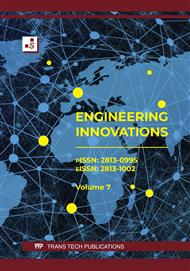[1]
B.H. Abubakar, R. Putrajaya, H. Abdulaziz, Malaysian rice husk ash-improving the durability and corrosion resistance of concrete: pre-view, Conc. Res. Let. 1(1) (2010) 6-13.
Google Scholar
[2]
A.I. Hashim, Lime-clay stabilization of lateritic soil for use in building construction, Unpublished M.Sc Thesis, Ahmadu Bello University, Zaria Nigeria (1992).
Google Scholar
[3]
G.S. Olaoye, N.A. Anigbogu, Properties of compressed earth bricks stabilized with termite mound materials, Nigerian J. Constr. Tech. Managem. 3(1) (2000) 150-156.
Google Scholar
[4]
S.O. Odeyemi, R. Abdulwahab, M.A. Anifowose, R.J. Ibrahim, Impact of different fine aggregates on the compressive strength of sandcrete blocks, Arid Zone J. of Eng. Tech. Env. 15(3) (2019) 611-618.
Google Scholar
[5]
S.O. Odeyemi, M.A. Anifowose, S.A. Bello, Z.T. GIWA, U.N. Wilson, Strength properties and microstructure of sandcrete blocks incorporated with maize straws, Advan. Eng. Forum, 46 (2022) 71-78.
DOI: 10.4028/p-kgoezq
Google Scholar
[6]
A.A. Raheem, A.K. Momoh, A.A. Soyingbe, Comparative analysis of sandcrete hollow blocks and laterite interlocking blocks as walling elements, Int. J. Sustain. Const. Eng. Tech. 3(1) (2012) 79-88.
Google Scholar
[7]
A.A. Raheem, O.K. Sulaiman, Saw dust ash as partial replacement for cement in the production of sandcrete hollow blocks, Int. J. Eng. Res. Applicat. 3(4) (2013) 713-721.
Google Scholar
[8]
D. Neslihan, N. Adnan, Traditional manufacturing of clay bricks in the historical building of diyarbakir, Frontiers Architect. Res. 6 (2017) 346-359.
Google Scholar
[9]
J.I. Aguwa, Performance of laterite-cement blocks as walling units in relation to sandcrete blocks, Leonardo Electron. J. Practic. Technolog. 9(16) (2010) 189-200.
Google Scholar
[10]
S.O. Odeyemi, M.A. Akinpelu, O.D. Atoyebi, R.T. Yahaya, R.T. Determination of load carrying capacity of clay bricks reinforced with straw, Int. J. Sust. Constr. Eng. Techn. 8(2) (2017) 57-65.
Google Scholar
[11]
E.A. Adam, A.R.A Agib, Compressed stabilized earth block manufacture in Sudan, United Nations Educational Scientific and Cultural Organization (UNESCO) Paris, (2001) Available at: http://www.growingempowered.org/wp-content/uploads/2016/02/Compressed-Earth-Building-Block-Guide.pdf
Google Scholar
[12]
R. Abdulwahab, T.M. Akinleye, The effects of production methods on the compressive strength of hollow sandcrete blocks, J. Mat. Eng. Struct. 3 (2016) 197-204.
Google Scholar
[13]
B.M. Das, Principles of geotechnical engineering 3rd ed., PWS Publishing, Boston, Massachusetts, (1994)
Google Scholar
[14]
National Building Code, Federal Republic of Nigeria National Building Code, Abuja, Nigeria (2006).
Google Scholar
[15]
ASTM D-3282 Standard Practice for Classification of Soils and Soil-Aggregate Mixtures for Highway Construction Purposes, American Society for Testing and Materials (ASTM International), West Conshohocken, PA (Reapproved 2004) (1993).
Google Scholar
[16]
NIS 554, Nigerian standard for drinking water quality, Nigerian Industrial Standard, Standard Organisation of Nigeria, Lagos, Nigeria (2007).
Google Scholar
[17]
BS EN ISO 17892-12, Geotechnical investigation and testing. Laboratory testing of soil, British Standards, London, (2018).
Google Scholar
[18]
BS EN 933-1 Tests for Geometrical Properties of Aggregates - Part 1: Determination of particle size distribution - sieving method, British Standards, London, (2012).
DOI: 10.3403/01236185u
Google Scholar
[19]
ASTM, D-4318, Standard test methods for liquid limit, plastic limit, and plasticity index of soils, American Society for Testing and Materials (ASTM International), West Conshohocken, PA (2018).
Google Scholar
[20]
ASTM C773-88, Standard test method for compressive (crushing) strength of fired whiteware materials, American Society for Testing and Materials (ASTM International), West Conshohocken, PA (2011).
DOI: 10.1520/c0773-88r11
Google Scholar
[21]
C.A. Oyelami, Suitability of Lateritic Soils as Construction Material in Sustainable Housing Development in Africa: A Geological Perspective, Unpublished PhD Thesis, University of Pretoria, Pretoria (2017).
Google Scholar
[22]
O.O. Olofinyo, O.F. Olabode, I.O. Fatoyinbo, Engineering properties of residual soils in part of southwestern Nigeria: implication for road foundation. SN Applied Sci. 1, (2019) 507.
DOI: 10.1007/s42452-019-0515-3
Google Scholar
[23]
J.A. Ige, B.A. Ibitoye, M.B. Kazeem, Geotechnical properties of Offa lateritic soils and its suitability as subbase and base materials, Int. J. of Civ. Struct. Eng. Res. 8(1) (2020) 196-203.
Google Scholar
[24]
O. Ademila, Engineering evaluation of lateritic soils of failed highway sections in southwestern Nigeria, Geosciences Res. 2(3) (2017) 210-218.
DOI: 10.22606/gr.2017.23006
Google Scholar
[25]
ASTM D-2487 Standard Practice for Classification of Soils for Engineering Purposes (Unified Soil Classification System), American Society for Testing and Materials (ASTM International), West Conshohocken, PA, (2006).
Google Scholar
[26]
M.C.J. Delgado, IC. Guerrero, Earth building in Spain, Const. Build. Mat. 20(9) (2006) 679-690.
Google Scholar
[27]
NIS 87, Specification for standard sandcrete blocks, Nigerian Industrial Standard, Standard Organization of Nigeria, Lagos, Nigeria, (2007).
Google Scholar
[28]
A.A. Kadir, A. Mohajerani, Physical and mechanical properties of fired clay bricks incorporated with cigarette butts: comparison between slow and fast heating rates, Applied Mechan. Mat. 421 (2013) 201-204.
DOI: 10.4028/www.scientific.net/amm.421.201
Google Scholar
[29]
O.F. Timothy, A.P. Azodo, W.K. Joshua, The effect of burnt clay brick production process on the compressive strength and water absorption properties, SNRU J. of Sci. Technol. 13(2) (2021) 63-70 .
Google Scholar
[30]
E. J. Bassah, W. K. Joshua, Assessing the correlation between brick properties and firing hours of locally produced clay-burnt bricks in Taraba state, Nigeria, European J. of Eng. Technol. Res. 6(1) (2021) 58-62.
DOI: 10.24018/ejers.2021.6.1.2324
Google Scholar
[31]
N. Phonphuak, C. Saengthong, A. Srisuwan, Physical and mechanical properties of fired clay bricks with rice husk waste addition as construction materials, Materials Today: Proceedings, 17 (2019) 1668-1674.
DOI: 10.1016/j.matpr.2019.06.197
Google Scholar


